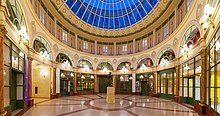Institut National d'Histoire de l'Art

The Institut National d'Histoire de l'Art (French: Institut national d'histoire de l'art, National Institute for Art History), commonly abbreviated INHA, is a French research institute, created and governed by Decree No. 2001-621 (July 12, 2001),[1] and situated in Paris. The Institute develops scientific activity and contributes to international cooperation in most fields of art history and heritage by exercising research, training and knowledge-diffusion.[2]
Headquarters
[edit]The reception area of INHA's headquarters is located at 2 rue Vivienne in the Galerie Colbert, part of the former 17th-century town house of Jean-Baptiste Colbert converted into a gallery in the 19th century.[3][4] INHA's Department of Education and Research (Département des Études et de la Recherche, DER) is also located at this site.[5]
Library
[edit]
INHA's art history library is in the former reading room of the Bibliothèque nationale de France (BnF), the Salle Labrouste (designed by the architect Henri Labrouste and completed in 1867[6]), which is located at 58 rue de Richelieu in the Richelieu Quadrilateral Area of what is now the Site Richelieu of the BnF.[7] It is the responsibility of the Department of the Library and Documentation (Département de la Bibliothèque et de la Documentation, DBD).[8]
The core of the library's collections was derived from the Art and Archeology Library founded by Jacques Doucet in 1897 and donated in 1917 to the University of Paris.[9] Doucet's library (formerly located at the Institut d'Art et d'Archéologie[10]) was transferred in 1992 to the Site Richelieu's Salle Ovale[11] and, after coming under the management of INHA in 2003,[9] was eventually moved to the nearby Salle Labrouste, where it opened on 15 December 2016.[12]
Further acquisitions have expanded the collections of INHA's library to include approximately 1,800 manuscripts, 20,000 rare books, 30,000 prints and drawings (including ones by Manet, Degas, Toulouse-Lautrec, Van Gogh, and Matisse; exceptional Japanese prints by Utamaro; and a rich collection of posters), more than 45,00 autograph letters by artists and art critics, 96,000 cartons of exposition invitations (an inexhaustible source of information concerning the circulation of works of art), and 750,000 photographs.[13]
Activities
[edit]The INHA's mission is to promote international art historical research in all fields of the history of art. It pilots many programs by gathering together university researchers and curators. It organises study days, symposiums, conferences and meeting-debates and develops different resources, documentary bases and research programs in art history. Each year, the INHA invites about sixty art historians, among them experienced researchers, academics, curators, art critics and doctoral students. Twice a year, the INHA publishes a scientific review on art history entitled Perspective. Many documentary bases are to be found on the INHA's website.[2]
The INHA provides access to external and internal online databases like AGORHA (Accès global et organisé aux ressources en histoire de l’art) which allows several search modes in the different research fields of the INHA: general search (or use « Rechercher » in the bar), simple search, expert search and search by links, in particular in the RETIF (Répertoire des tableaux italiens dans les collections publiques françaises (XIIIe-XIXe siècles)) which gives (clic on Oeuvres) the 13,844 Italian paintings held in French public collections.
References
[edit]- ^ Organisation et instances – INHA
- ^ a b INHA's missions
- ^ "The Institut National d'Histoire de l'Art (INHA)", The Chancellerie des Universités de Paris.
- ^ Alexandre Gady (2008). "Bautru (hôtel de)", p. 306, in Les Hôtels particuliers de Paris du Moyen Âge à la Belle Époque. Paris: Parigramme. ISBN 9782840962137.
- ^ "Le département des Études et de la Recherche".
- ^ Andrew Ayers (2004). The Architecture of Paris. Paris: Éditions Axel Menges. "2.4 Bibliothèque Nationale", pp. 58–59. ISBN 9783930698967.
- ^ La bibliothèque de l'INHA, INHA.
- ^ Le Département de la Bibliothèque et de la Documentation (DBD)
- ^ a b "INHA's library" (archive copy)
- ^ "Bibliothèque de l'INHA – Collections Jacque Doucet". pharosartresearch.org. Retrieved 2021-02-03.
- ^ Les sites de l'INHA et leur patrimoine, INHA.
- ^ "La nouvelle bibliothèque de l'INHA", pp. 8–9, in Agenda, INHA, April–July 2017.
- ^ "Les collections de la bibliothèque de l'INHA", INHA website.
External links
[edit]- INHA's main English page
- INHA's missions
- Chancellerie des Universités de Paris: The Institut National d'Histoire de l'Art (INHA)
- Institut National d'Histoire de l'Art: lNHA's library
- Institut National d'Histoire de l'Art: Les outils documentaires (databases) de l'INHA
- Institut National d'Histoire de l'Art: Les publications de l'INHA
- Institut National d'Histoire de l'Art: Les publications numériques de l'INHA
| International | |
|---|---|
| National | |
| People | |
| Other | |
Text is available under the CC BY-SA 4.0 license; additional terms may apply.
Images, videos and audio are available under their respective licenses.
